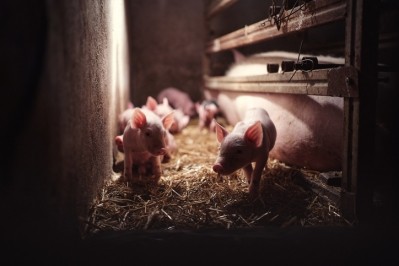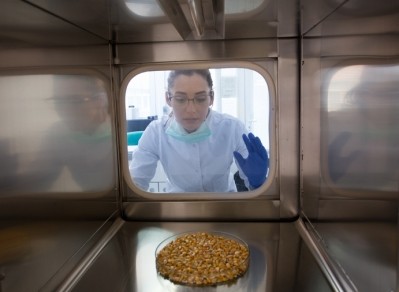Reports from IPPE
Novus on preparing a young animal’s immune system and gut

We sat down with Mercedes Vazquez-Añon, director of animal research, and Scott Hine, VP of products, solutions and chief innovation officer, both with Novus International during the International Production and Processing Expo (IPPE) in Atlanta to hear more about the research the company is doing and upcoming areas for exploration and development.
The Missouri-based feed additive company has focused on providing innovative products to the market and developing new or novel uses of feed additives, said Hine.
“We really believe that by understanding our customers’ issues and their specific requirements we can help them formulate and apply our products on their own, or in concert with other complementary products that are going to help deliver value in terms of improving performance, profitability, and making their products higher quality and more desirable to the end consumer,” he said.
Research and development highlights
Part of the company’s development efforts includes a three-prong research focus, said Vazquez-Añon. Novus’ research work highlights the areas of maternal feeding, gut health and structural health and meat quality.
The areas were selected for their relevance to the industry and from customers’ feedback, she said.
“On maternal feeding, what we’re finding is that what you feed to the mother really has an impact in the development of the progeny,” she said. “It’s not only on the profitability of that mother – the hen, breeder, sow or cow – it’s that the benefits are truly carried to the next generation.”
Young animals need to develop so quickly, that producers “almost run out of time,” she added.
By focusing on maternal nutrition, the young animals may see improved embryonic development and start in a better position, Vazquez-Añon said. Maternal nutrition practices can improve gut health, the gut immune system and muscle development, initially and throughout the animal’s life.
“It means that animal has a stronger immune system early on to fight the challenges that will come throughout the lifecycle,” she said. “We’re also finding that we see an impact in muscle development that will affect the muscle fibers and the maturation of the muscle fibers in the very young piglet, calf and chicken.”
Preparing a young animal’s immune system and gut to face challenges also has a link to the work producers are doing in moving away from the use of antibiotics, she said. “We’ve been studying what happens physiologically in the animal in the absence of antibiotics – the young animal is exposed to a wide microflora, which is good, but it allows the opportunity for pathogens to grow,” she added.
Coccidia, clostridium and necrotic enteritis remain challenges for poultry producers, she said. However, supporting the development of the immune system and controlling the development of the bird’s microflora help reduce dysbacteriosis and overgrowth of pathogens.
“We believe in a holistic approach when resolving gut challenges – for example, there is a great opportunity to improve ingredient quality and digestibility with enzymes, so you reduce the risk of hindgut fermentation and dysbacteriousis,” Vazquez-Añon said. “Secondly, you improve the immune system of the animal through a well-balanced trace mineral nutrition program, and then you control the microflora in the gut so you don’t have an overgrowth of clostridium or other pathogens
“It’s the diet, the immune system and the microflora,” she added. “Pay attention to these three areas and you reduce the chances of something happening.”
Novus’s research aimed at improving ingredient quality and reducing the variation of feed ingredients is part of these efforts, she said.
“We’re spending a lot of time understanding soybean quality variation by measuring the content of trypsin inhibitors because soybean meal is the biggest protein used worldwide and has the biggest inclusion level,” she said. “Moderate levels of trypsin inhibitor in soybean meal can cause digestive problems in birds and pigs.”
Although Novus has development a mitigant to address anti-nutritional trypsin inhibitor, the company also is planning to expand its enzyme portfolio, said Vazquez-Añon. “We have our protease, and now we have a phytase and we’ll be looking for other sources of enzymes that help reduce anti-nutritional factors and manage ingredient quality variation – that work is still ongoing,” she added.
Novus also has been working with identifying the levels of trace minerals, or chelated minerals, needed to help production animals cope with inflammation and deliver an immune response in face of a challenge, she said. Similarly, research examining encapsulated organic acids is being done to address controlling the microflora.
Some of the milestones that Novus set for its research efforts include having industry adopt practices that the company has developed – which has happened with some of the maternal feeding work, Vazquez-Añon said. In gut health, the goal is to understand and solve industry challenges.
“We have also worked at understanding the reason behind myopathies that cause woody breast and white striping,” she said. “Now that we have a better understanding of the physiology of the problem and we see acceptance in the marketplace by our customers using our program to reduce the incidence of these maladies – that’s the end result that we’re looking for.”
“By the end of next year, our team might be working on different challenges because problems keep coming up in the industry,” she added.
Market position, future development
As Novus looks to the future, the goal is to support producers seeking to generate a high-quality product for their end market, said Hine. “I also see us continuing to have a role as an innovator – innovation doesn’t always mean I just developed a new product, it’s also what did I find out or discover that that product provides a benefit or an answer to?”
Part of that effort is to expand the understanding of how Novus’ offerings fit with the other products, like vaccines, that a producer might be using, he said.
Another piece is understanding of how Novus’ products work and interact “down to the physiology and the biochemistry,” Hine said. Company research with industry partners into preventing white-striping and woody breast in poultry followed this process.
Additionally, there continues to be a focus on sustainability and helping producers have less waste, generate less pollution and improved use of feed ingredients, he said.
“One of the key things we’re trying to do, when we’re looking at the future and products is trying not only to meet the needs of our customers but also meet the needs of the industry and the environment in which we operate,” he added.

















